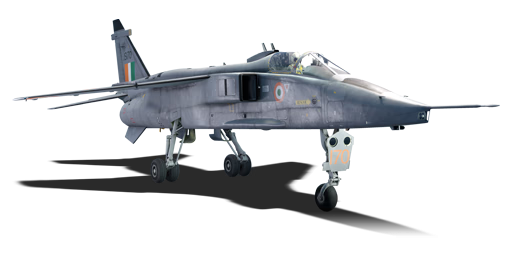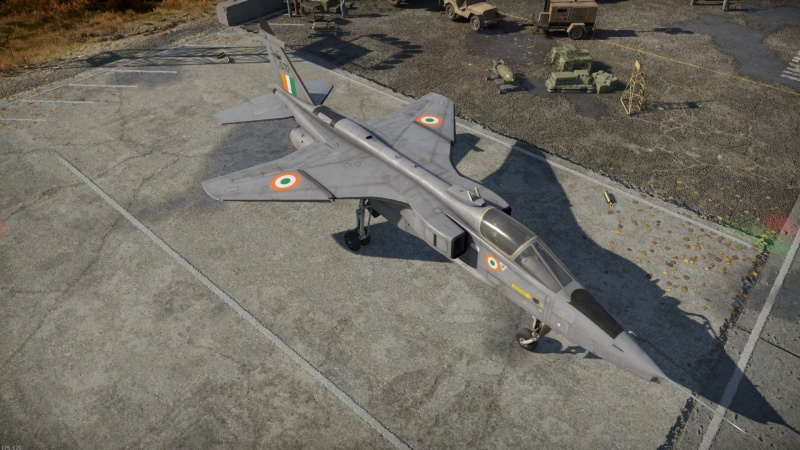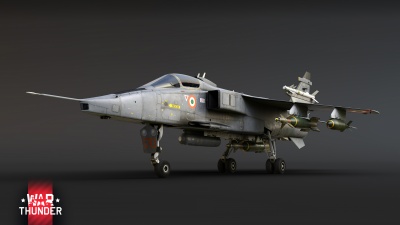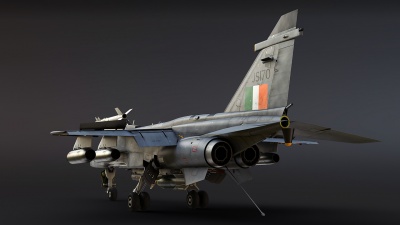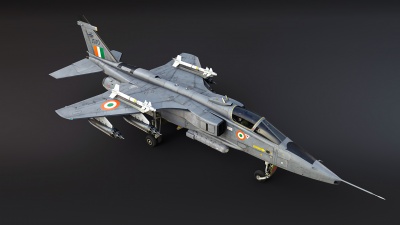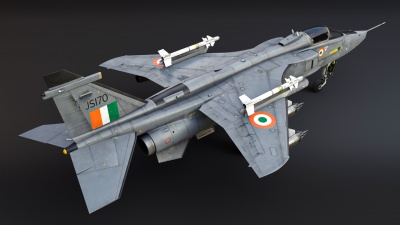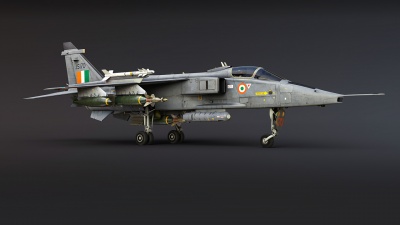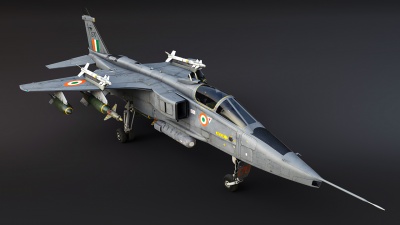Difference between revisions of "Jaguar IS"
m (Expanded media section) |
(→Engine performance) |
||
| (7 intermediate revisions by 4 users not shown) | |||
| Line 7: | Line 7: | ||
|code=jaguar_is | |code=jaguar_is | ||
|images={{Specs-Card-Image|GarageImage_{{PAGENAME}}.jpg}} | |images={{Specs-Card-Image|GarageImage_{{PAGENAME}}.jpg}} | ||
| + | |market=id50259_jaguar_is_great_britain | ||
}} | }} | ||
| Line 21: | Line 22: | ||
While it is indeed supersonic, the jet does not have particularly remarkable performance, and is outclassed by most of its contemporaries. It has lacklustre engine power and poor aerodynamics, lending to an inability to supercruise, lacklustre acceleration and terrible energy retention. | While it is indeed supersonic, the jet does not have particularly remarkable performance, and is outclassed by most of its contemporaries. It has lacklustre engine power and poor aerodynamics, lending to an inability to supercruise, lacklustre acceleration and terrible energy retention. | ||
| − | Thankfully, the Jaguar IS does have rather robust engines that are very slow to overheat, and give ample time to reduce throttle before incurring any damage to the engines. Additionally, it has adequate manoeuvrability and among the best nose authority of any aircraft in the game, rivalled only by other Jaguar variants. This gives the aircraft the ability to force the nose towards an enemy, thereby bringing the guns on-target. This | + | Thankfully, the Jaguar IS does have rather robust engines that are very slow to overheat, and give ample time to reduce throttle before incurring any damage to the engines. Additionally, it has adequate manoeuvrability and among the best nose authority of any aircraft in the game, rivalled only by other Jaguar variants. This gives the aircraft the ability to force the nose towards an enemy, thereby bringing the guns on-target. This ability often catches enemies off-guard, and can net a quick and satisfying kill from time-to-time. |
| + | |||
| + | As an aside, it's worth noting that the Jaguar IS, like all Jaguar variants, has extremely useful "combat flaps". This is because unlike most aircraft, this aircraft engages its "combat flaps" merely by deflecting the elevators downwards by an additional few degrees. This means that it is impossible to rip the combat flaps off, even at supersonic speeds, allowing for a useful boost to the already excellent nose authority and manoeuvrability. | ||
{| class="wikitable" style="text-align:center" width="70%" | {| class="wikitable" style="text-align:center" width="70%" | ||
| Line 81: | Line 84: | ||
|- | |- | ||
! colspan="3" | Engine | ! colspan="3" | Engine | ||
| − | ! colspan=" | + | ! colspan="6" | Aircraft mass |
|- | |- | ||
! colspan="2" | Engine name || Number | ! colspan="2" | Engine name || Number | ||
| − | ! colspan=" | + | ! colspan="3" | {{Annotation|Basic mass|Mass of the aircraft with pilot and engine oil, but no fuel or weapons load}} || colspan="3" | Wing loading (full fuel) |
|- | |- | ||
| colspan="2" | Rolls-Royce Turbomeca Limited Adour Mk.811 || 2 | | colspan="2" | Rolls-Royce Turbomeca Limited Adour Mk.811 || 2 | ||
| − | | colspan=" | + | | colspan="3" | 7,616 kg || colspan="3" | 453 kg/m<sup>2</sup> |
|- | |- | ||
! colspan="3" | Engine characteristics | ! colspan="3" | Engine characteristics | ||
| − | ! colspan=" | + | ! colspan="5" | Mass with fuel (no weapons load) || rowspan="2" | {{Annotation|Max Gross<br>Weight|Mass of the fully equipped aircraft with heaviest weapons load}} |
|- | |- | ||
! Weight (each) || colspan="2" | Type | ! Weight (each) || colspan="2" | Type | ||
| − | ! | + | ! 14m fuel || 20m fuel || 30m fuel || 45m fuel || 49m fuel |
|- | |- | ||
| − | | 709 kg || colspan="2" | | + | | 709 kg || colspan="2" | Afterburning low-bypass turbofan |
| − | | | + | | 8,592 kg || 8,937 kg || 9,597 kg || 10,587 kg || 10,869 kg || _,___ kg |
|- | |- | ||
! colspan="3" | {{Annotation|Maximum engine thrust @ 0 m (RB/SB)|The maximum thrust produced by each engine, while mounted in the aircraft. NOTE: Thrust varies significantly depending on speed & altitude.}} | ! colspan="3" | {{Annotation|Maximum engine thrust @ 0 m (RB/SB)|The maximum thrust produced by each engine, while mounted in the aircraft. NOTE: Thrust varies significantly depending on speed & altitude.}} | ||
| − | ! colspan=" | + | ! colspan="6" | Thrust to weight ratio @ 0 m (WEP) |
|- | |- | ||
| − | ! Condition || 100% || | + | ! Condition || 100% || WEP |
| − | ! | + | ! 14m fuel || 20m fuel || 30m fuel || 45m fuel || 49m fuel || MGW |
|- | |- | ||
| − | | ''Stationary'' || | + | | ''Stationary'' || 2,300 kgf || 3,630 kgf |
| − | | | + | | 0.84 || 0.81 || 0.76 || 0.69 || 0.67 || _.__ |
|- | |- | ||
| − | | ''Optimal'' || | + | | ''Optimal'' || 2,424 kgf<br>(200 km/h) || 3,636 kgf<br>(200 km/h) |
| − | | | + | | 0.85 || 0.81 || 0.76 || 0.69 || 0.67 || _.__ |
|- | |- | ||
|} | |} | ||
| Line 152: | Line 155: | ||
|- | |- | ||
! !! width="5%" | 1 !! width="5%" | 2 !! width="5%" | 3 !! width="5%" | 4 !! width="5%" | 5 !! width="5%" | 6 !! width="5%" | 7 !! width="5%" | 8 | ! !! width="5%" | 1 !! width="5%" | 2 !! width="5%" | 3 !! width="5%" | 4 !! width="5%" | 5 !! width="5%" | 6 !! width="5%" | 7 !! width="5%" | 8 | ||
| − | | rowspan=" | + | | rowspan="10" width="30%" | <!-- <div class="ttx-image">[[File:Hardpoints_{{PAGENAME}}.png]]</div> --> |
|- | |- | ||
! [[Mk.M2 (540 lb)|540 lb Mk.M2]] bombs | ! [[Mk.M2 (540 lb)|540 lb Mk.M2]] bombs | ||
| Line 177: | Line 180: | ||
! LITENING II targeting pod | ! LITENING II targeting pod | ||
| || || || 1* || || || || | | || || || 1* || || || || | ||
| + | |- | ||
| + | ! 264 gal drop tanks | ||
| + | | || 1 || || || 1 || || 1 || | ||
|- | |- | ||
| colspan="10" | * The LITENING II pod must be carried when equipping Mk.13 bombs | | colspan="10" | * The LITENING II pod must be carried when equipping Mk.13 bombs | ||
| Line 185: | Line 191: | ||
{{Navigation-First-Simple-Line}} | {{Navigation-First-Simple-Line}} | ||
| − | * | + | * 3 x 264 gal drop tanks |
* 2 x Matra R550 Magic 2 missiles | * 2 x Matra R550 Magic 2 missiles | ||
* 8 x 540 lb Mk.M2 bombs (4,320 lb total) | * 8 x 540 lb Mk.M2 bombs (4,320 lb total) | ||
| Line 211: | Line 217: | ||
== Usage in battles == | == Usage in battles == | ||
<!-- ''Describe the tactics of playing in the aircraft, the features of using aircraft in a team and advice on tactics. Refrain from creating a "guide" - do not impose a single point of view, but instead, give the reader food for thought. Examine the most dangerous enemies and give recommendations on fighting them. If necessary, note the specifics of the game in different modes (AB, RB, SB).'' --> | <!-- ''Describe the tactics of playing in the aircraft, the features of using aircraft in a team and advice on tactics. Refrain from creating a "guide" - do not impose a single point of view, but instead, give the reader food for thought. Examine the most dangerous enemies and give recommendations on fighting them. If necessary, note the specifics of the game in different modes (AB, RB, SB).'' --> | ||
| + | As a few brief general notes about this aircraft, it is worth considering that the use of the yaw-axis on landing is potentially a death sentence. Unlike most aircraft, the Jaguar cannot deflect its rudder along the yaw-axis to further aid in deceleration due to the design of its tricycle landing gear and its high centre-of-mass. Any attempt to deflect the rudder during landing is likely to cause a roll-over, which will knock out the pilot in most circumstances. On the plus side, the Jaguar has access to a very effective set of air-brakes and landing flaps, as well as a drag chute which is more than enough to comfortably bring the aircraft to a halt. | ||
| + | |||
| + | Additionally, the Jaguar IS has "combat flaps" that can be deflected at any speed due to their unique design. This means that they can be employed to gain a boost of manoeuvrability, even at supersonic speeds. | ||
| + | |||
=== Air Battles === | === Air Battles === | ||
| Line 238: | Line 248: | ||
==== Air Simulator ==== | ==== Air Simulator ==== | ||
The Jaguar IS is a capable aircraft in Air Simulator, although its lack of radar severely hampers it. If encountering an enemy, the Magic 2 all-aspect missiles are exceptionally hard to dodge, although it is unlikely you will notice an enemy before they notice you considering most aircraft have radar at this tier. | The Jaguar IS is a capable aircraft in Air Simulator, although its lack of radar severely hampers it. If encountering an enemy, the Magic 2 all-aspect missiles are exceptionally hard to dodge, although it is unlikely you will notice an enemy before they notice you considering most aircraft have radar at this tier. | ||
| + | |||
| + | The Jaguar IS is a pleasure to fly in Air Simulator battles, offering a remarkably smooth and reliable flight. The Jaguar series was originally designed as a supersonic jet trainer aircraft, and this shows, as it is an incredibly easy aircraft to fly with no "quirks" that can throw the pilot off. Not only are its "combat flaps" indestructible allowing for incredibly tight turns at high speeds, it has a particularly sleek cockpit design with the pilot seated higher in the canopy than most, giving excellent visibility around the aircraft. | ||
| + | |||
| + | Furthermore, the flight model is such that it is very difficult to put the Jaguar IS into a flat-spin, and recovery is a relatively simple; all in all, the aircraft is very obedient and does not need to be "tamed" - if the pilot wills it, it will be done. Fighting against the controls is a rarity, a refreshing experience coming from the Harriers the British tech tree is tasked with flying around this tier. Even if the aircraft sustains critical damage to the control surfaces, avionics - or even loses the tip of its wing - it is still often flyable albeit with a bit of effort. | ||
For safe and reliable gameplay, it is advised to carry the maximum bombload to target enemy bases, as this is consistently the most reliable and safest way to earn points for your team in this vehicle. The dumb bombs are also more than capable of taking out most naval targets since their anti-air capabilities are largely redundant in this game mode. The head-up display (HUD) shows the bomb CCRP when selected. | For safe and reliable gameplay, it is advised to carry the maximum bombload to target enemy bases, as this is consistently the most reliable and safest way to earn points for your team in this vehicle. The dumb bombs are also more than capable of taking out most naval targets since their anti-air capabilities are largely redundant in this game mode. The head-up display (HUD) shows the bomb CCRP when selected. | ||
| Line 243: | Line 257: | ||
However, should the player wish to target an aircraft carrier, or other ground units escorted by SPAAGs, it is best to use the guided bombs instead. This is because SPAAGs and carrier anti-air batteries are absolutely ruthless in Air Simulator battles, and a distance of at least a kilometre must be maintained at all times. | However, should the player wish to target an aircraft carrier, or other ground units escorted by SPAAGs, it is best to use the guided bombs instead. This is because SPAAGs and carrier anti-air batteries are absolutely ruthless in Air Simulator battles, and a distance of at least a kilometre must be maintained at all times. | ||
| − | It is imperative to bring chaff in Air Simulator due to the increased reliance on radar-guided missiles and medium ranged combat in this game mode. | + | It is imperative to bring chaff in Air Simulator due to the increased reliance on radar-guided missiles and medium ranged combat in this game mode. Keep your eyes on your Radar Warning Receiver, it will come to be your best friend. |
The recommended payload in this game mode is either: | The recommended payload in this game mode is either: | ||
| Line 256: | Line 270: | ||
* 1 x LITENING targeting pod | * 1 x LITENING targeting pod | ||
* 3 x Mk.13 guided bombs | * 3 x Mk.13 guided bombs | ||
| + | * 30 x flares & 30 x chaff | ||
=== Ground Battles === | === Ground Battles === | ||
| Line 302: | Line 317: | ||
* Excellent nose-authority | * Excellent nose-authority | ||
* Constantly Computed Impact Point (CCIP) available for all ordnance | * Constantly Computed Impact Point (CCIP) available for all ordnance | ||
| + | * Indestructible combat flaps | ||
'''Cons:''' | '''Cons:''' | ||
| Line 339: | Line 355: | ||
File:Jaguar IS WTWallpaper 06.jpg| | File:Jaguar IS WTWallpaper 06.jpg| | ||
</gallery> | </gallery> | ||
| + | |||
| + | ;Videos | ||
| + | {{Youtube-gallery|3XGsrLteeZM|'''The Shooting Range #397''' - ''Metal Beasts'' section at 00:27 discusses the {{PAGENAME}}.}} | ||
== See also == | == See also == | ||
Latest revision as of 08:57, 4 August 2024
| This page is about the British strike aircraft Jaguar IS. For other versions, see Jaguar (Family). |
Contents
Description
The Jaguar IS is an Indian variant of the SEPECAT Jaguar, a supersonic jet attack aircraft that emerged as a joint Anglo-French venture for a supersonic jet trainer with light ground attack capabilities. One of many export variants, this vehicle has seen extensive service in its more than 40 years of continuous service, arming Indian squadrons since 1981.
Introduced during Update "Air Superiority" as a reward for the 2024 Sword of Justice event, the Jaguar IS sports rather modest suspended ordnance, especially when compared to its contemporaries. Nonetheless, it can pack quite a heavy punch, with a bombload of up to 8,000 lbs. The Jaguar IS retains the over-wing air-to-air missile pylons that made the Jaguar GR.1A so unique, meaning that this jet does not compromise on air-to-air capabilities, regardless of the air-to-ground ordnance selected. And these are no ordinary missiles: the pair of Matra R550 Magic 2s are incredibly potent.
General info
Flight performance
While it is indeed supersonic, the jet does not have particularly remarkable performance, and is outclassed by most of its contemporaries. It has lacklustre engine power and poor aerodynamics, lending to an inability to supercruise, lacklustre acceleration and terrible energy retention.
Thankfully, the Jaguar IS does have rather robust engines that are very slow to overheat, and give ample time to reduce throttle before incurring any damage to the engines. Additionally, it has adequate manoeuvrability and among the best nose authority of any aircraft in the game, rivalled only by other Jaguar variants. This gives the aircraft the ability to force the nose towards an enemy, thereby bringing the guns on-target. This ability often catches enemies off-guard, and can net a quick and satisfying kill from time-to-time.
As an aside, it's worth noting that the Jaguar IS, like all Jaguar variants, has extremely useful "combat flaps". This is because unlike most aircraft, this aircraft engages its "combat flaps" merely by deflecting the elevators downwards by an additional few degrees. This means that it is impossible to rip the combat flaps off, even at supersonic speeds, allowing for a useful boost to the already excellent nose authority and manoeuvrability.
| Characteristics | Max speed (km/h at 10,668 m) |
Max altitude (metres) |
Turn time (seconds) |
Rate of climb (metres/second) |
Take-off run (metres) | |||
|---|---|---|---|---|---|---|---|---|
| AB | RB | AB | RB | AB | RB | |||
| Stock | 1,576 | 1,558 | 13716 | 31.6 | 32.2 | 86.2 | 78.2 | 850 |
| Upgraded | ___ | ___ | __._ | __._ | __._ | __._ | ||
Details
| Features | |||||
|---|---|---|---|---|---|
| Combat flaps | Take-off flaps | Landing flaps | Air brakes | Arrestor gear | Drogue chute |
| ✓ | ✓ | ✓ | ✓ | ✓ | ✓ |
| Limits | ||||||
|---|---|---|---|---|---|---|
| Wings (km/h) | Gear (km/h) | Flaps (km/h) | Max Static G | |||
| Combat | Take-off | Landing | + | - | ||
| 1,273 | 481 | 1,273 | 525 | 410 | ~__ | ~__ |
| Optimal velocities (km/h) | |||
|---|---|---|---|
| Ailerons | Rudder | Elevators | Radiator |
| < ___ | < ___ | < ___ | > ___ |
Engine performance
| Engine | Aircraft mass | |||||||
|---|---|---|---|---|---|---|---|---|
| Engine name | Number | Basic mass | Wing loading (full fuel) | |||||
| Rolls-Royce Turbomeca Limited Adour Mk.811 | 2 | 7,616 kg | 453 kg/m2 | |||||
| Engine characteristics | Mass with fuel (no weapons load) | Max Gross Weight | ||||||
| Weight (each) | Type | 14m fuel | 20m fuel | 30m fuel | 45m fuel | 49m fuel | ||
| 709 kg | Afterburning low-bypass turbofan | 8,592 kg | 8,937 kg | 9,597 kg | 10,587 kg | 10,869 kg | _,___ kg | |
| Maximum engine thrust @ 0 m (RB/SB) | Thrust to weight ratio @ 0 m (WEP) | |||||||
| Condition | 100% | WEP | 14m fuel | 20m fuel | 30m fuel | 45m fuel | 49m fuel | MGW |
| Stationary | 2,300 kgf | 3,630 kgf | 0.84 | 0.81 | 0.76 | 0.69 | 0.67 | _.__ |
| Optimal | 2,424 kgf (200 km/h) |
3,636 kgf (200 km/h) |
0.85 | 0.81 | 0.76 | 0.69 | 0.67 | _.__ |
Survivability and armour
The aircraft has no armour to speak of, thus the pilot, engines, and fuel tanks are vulnerable to stray shrapnel. This can lead to a "pilot-snipe", or set fire to the vehicle, a particularly common cause of death considering the Jaguar IS lacks any engine fire systems or fire-prevention equipment.
However, the Jaguar IS does have access to ample countermeasures including both flares and chaff. With 60 slots, it's by no means indulgent when compared to other aircraft like the Harrier GR.7, but it is more than enough to last most sorties in both Realistic and Simulator battles. This is compounded by its modern Radar Warning Receiver, which can detect radar bands E-J, Pulse Doppler, Track While Scan, and even Continuous-Wave radar. Furthermore, it is able to display the relative position of the radar source along 4 axes, which is sufficient for most use cases.
Modifications and economy
Armaments
| Ballistic Computer | ||||
|---|---|---|---|---|
| CCIP (Guns) | CCIP (Rockets) | CCIP (Bombs) | CCRP (Bombs) | EEGS |
| |
|
|
|
|
Offensive armament
The Jaguar IS is armed with:
- 1 x 30 mm ADEN Mk.4 cannon, belly-mounted (150 rpg)
- 60 x countermeasures
Suspended armament
The Jaguar IS can be outfitted with the following ordnance:
| 1 | 2 | 3 | 4 | 5 | 6 | 7 | 8 | ||
|---|---|---|---|---|---|---|---|---|---|
| 540 lb Mk.M2 bombs | 1 | 2 | 2 | 2 | 1 | ||||
| 1,000 lb H.E. M.C. Mk.13 No.117 bombs | 1 | 2 | 2 | 2 | 1 | ||||
| 1,000 lb H.E. M.C. Mk.13 bombs | 1 | 2 | 2 | 2 | 1 | ||||
| 546 kg Mk.13 bombs | 1* | 1* | 1* | ||||||
| CRV7 M247 rockets | 19 | 19 | 19 | 19 | |||||
| SNEB type 23 rockets | 18 | 18 | 18 | 18 | |||||
| Matra R550 Magic 2 missiles | 1 | 1 | |||||||
| LITENING II targeting pod | 1* | ||||||||
| 264 gal drop tanks | 1 | 1 | 1 | ||||||
| * The LITENING II pod must be carried when equipping Mk.13 bombs | |||||||||
| Default weapon presets | |
|---|---|
| |
Air-to-Air
The Jaguar IS sports a pair of Matra R550 Magic 2 heat-seeking air-to-air missiles, which are arguably some of the most capable weapons of its class in all of War Thunder. The Magic 2 has a 35G overload and an all-aspect uncaged seeker. Furthermore, it has IRCCM, rendering it practically all but immune to standard calibre flares in the rear-aspect. This means that a rear-aspect lock on a target is pretty much a guaranteed kill. This is especially the case in a down-tier, where opponents often lack flares entirely.
Air-to-Ground
As a strike fighter, the Jaguar IS could be assumed to have a diverse and powerful array of suspended ordnance. However, this is unfortunately not the case: it has a rather modest payload of up to 8,000 lb which is less than most of its peers. This means that it can only destroy one base (5,000 lb per base), with 3,000 lb to spare. Despite the somewhat mediocre payload, the CCRP for bombs as well as the fact that bombs are dropped one at a time (rather than in pairs) it can be very precise while delivering a sizeable payload. Assuming every bomb nets a kill (which is fairly reasonable given the explosive mass), the Jaguar IS can theoretically get as many as 8 kills - or more - in Ground Realistic battles.
It has access to up to 3 rather potent guided bombs which is above average for aircraft at its battle rating. This gives it excellent capability for long-range precision targeting, and is especially useful in Air Simulator, Ground Realistic, and Ground Simulator Battles.
Furthermore, the Jaguar IS can mount unguided rockets, however they are not particularly potent or reliable as a weapon. While they do have a lot of penetration due to their HEAT warheads, conventional dumb or guided bombs are more reliable. Rockets are only worth considering in some Enduring Confrontation scenarios where the player wishes to kill numerous ground targets in a single sortie.
The Jaguar IS has CCIP/CCRP for all available munitions and ordnance, allowing for precision target acquisition and bombardment. In the hands of a competent player, this pretty much guarantees that suspended armament will result in a kill.
Usage in battles
As a few brief general notes about this aircraft, it is worth considering that the use of the yaw-axis on landing is potentially a death sentence. Unlike most aircraft, the Jaguar cannot deflect its rudder along the yaw-axis to further aid in deceleration due to the design of its tricycle landing gear and its high centre-of-mass. Any attempt to deflect the rudder during landing is likely to cause a roll-over, which will knock out the pilot in most circumstances. On the plus side, the Jaguar has access to a very effective set of air-brakes and landing flaps, as well as a drag chute which is more than enough to comfortably bring the aircraft to a halt.
Additionally, the Jaguar IS has "combat flaps" that can be deflected at any speed due to their unique design. This means that they can be employed to gain a boost of manoeuvrability, even at supersonic speeds.
Air Battles
Air Arcade
The Jaguar IS is excellent in Air Arcade battles as a fighter. Its excellent manoeuvrability and nose authority grants it an unparalleled edge when compared to enemies. Furthermore, the flight models in Air Arcade better accommodate the quirks of the Jaguar airframe, minimising energy bleed while allowing the aircraft to pull manoeuvres otherwise impossible in other game modes. Unfortunately, the Jaguar IS has only a single 30 mm ADEN Mk.4 cannon, which reduces the likelihood of getting a kill from a glancing blow, increasing the time-to-kill. Luckily, the low velocity of this armament is accommodated by the presence of a lead indicator in this game mode.
Concerns regarding the scarcity of ammunition, countermeasures, and air-to-air ordnance are further alleviated in this game mode due to intermittent aerial rearmament upon running out of ammo.
Taking bombs is ill-advised at this battle rating due to the sheer onslaught of enemy aircraft, many of whom are quick to prey on strike jets like the Jaguar. Bomb targets in Air Arcade require more ordnance to successfully destroy than in Air Realistic battles, further condemning the rather lacklustre bombload of the Jaguar IS to mediocrity. It is for this reason that the recommended payload in Air Arcade battles is:
- 2 x Matra R550 Magic 2
- 30 x flares & 30 x chaff
Air Realistic
The Jaguar IS is poorly suited to Air Realistic battles on most occasions due to its inadequate top speed and acceleration, and its overall vulnerability to enemy aircraft. While it has excellent air-to-air missiles, it only has two of them, and thus it is imperative to stay avoid being swarmed by enemy aircraft since the Jaguar IS can only reliably take one or two enemies at a time. Plus, it is rarely able to destroy bomb targets since most teammates are in much faster aircraft and are able to reach and destroy all available bomb targets long before the Jaguar IS reaches the battlefield.
The recommended payload in Air Realistic Battles is:
- 2 x Matra R550 Magic 2
- 8 x 1,000 lb bombs
- 30 x flares & 30 x chaff
This loadout gives the player the ability to defend themselves against enemy aircraft while fulfilling its strike role. It is ill advised to focus on player-vs-player (PvP) gameplay due to the vulnerability and lacklustre air-to-air capabilities of the jet, and so the only other viable option is to focus on strike, with air-to-air kills as a bonus if the situation presents itself.
It is advised that the player loiter behind the frontlines, climbing to a high altitude, waiting for the bomb targets to respawn. Alternatively, the player can opt out of bombs, carrying Matra Magic 2 missiles exclusively, to go for a couple of quick kills before immediately retreating to base. At base, the player can then re-equip the larger payload aforementioned.
Air Simulator
The Jaguar IS is a capable aircraft in Air Simulator, although its lack of radar severely hampers it. If encountering an enemy, the Magic 2 all-aspect missiles are exceptionally hard to dodge, although it is unlikely you will notice an enemy before they notice you considering most aircraft have radar at this tier.
The Jaguar IS is a pleasure to fly in Air Simulator battles, offering a remarkably smooth and reliable flight. The Jaguar series was originally designed as a supersonic jet trainer aircraft, and this shows, as it is an incredibly easy aircraft to fly with no "quirks" that can throw the pilot off. Not only are its "combat flaps" indestructible allowing for incredibly tight turns at high speeds, it has a particularly sleek cockpit design with the pilot seated higher in the canopy than most, giving excellent visibility around the aircraft.
Furthermore, the flight model is such that it is very difficult to put the Jaguar IS into a flat-spin, and recovery is a relatively simple; all in all, the aircraft is very obedient and does not need to be "tamed" - if the pilot wills it, it will be done. Fighting against the controls is a rarity, a refreshing experience coming from the Harriers the British tech tree is tasked with flying around this tier. Even if the aircraft sustains critical damage to the control surfaces, avionics - or even loses the tip of its wing - it is still often flyable albeit with a bit of effort.
For safe and reliable gameplay, it is advised to carry the maximum bombload to target enemy bases, as this is consistently the most reliable and safest way to earn points for your team in this vehicle. The dumb bombs are also more than capable of taking out most naval targets since their anti-air capabilities are largely redundant in this game mode. The head-up display (HUD) shows the bomb CCRP when selected.
However, should the player wish to target an aircraft carrier, or other ground units escorted by SPAAGs, it is best to use the guided bombs instead. This is because SPAAGs and carrier anti-air batteries are absolutely ruthless in Air Simulator battles, and a distance of at least a kilometre must be maintained at all times.
It is imperative to bring chaff in Air Simulator due to the increased reliance on radar-guided missiles and medium ranged combat in this game mode. Keep your eyes on your Radar Warning Receiver, it will come to be your best friend.
The recommended payload in this game mode is either:
- 2 x Matra R550 Magic 2
- 8 x 1,000 lb bombs
- 30 x flares & 30 x chaff
or
- 2 x Matra R550 Magic 2
- 1 x LITENING targeting pod
- 3 x Mk.13 guided bombs
- 30 x flares & 30 x chaff
Ground Battles
Ground Arcade
You have no control over the aircraft you are allocated or the ordnance equipped in Ground Arcade. Play with the cards you are dealt. The Jaguar IS is considered a reward vehicle and is not present in the standard Ground Arcade air battle event pool; players are overwhelmingly unlikely to spawn this jet in Ground Arcade.
Ground Realistic
The Jaguar IS can pursue two playstyles in Ground Realistic battles. The first is the more conventional aggressive playstyle featuring unguided bombs. This method can net up to 8 kills in the hands of a skilled player using the CCRP, although it is necessary to get close to carry out such strikes, putting the aircraft in range of enemy self-propelled anti-aircraft guns (SPAAG). Alternatively, the player can opt for a safer, more cautions approach, using the guided bombs to target enemies with greater precision from longer range. The Jaguar IS can only carry up to 3 guided bombs, so this strategy typically nets less kills, but it is much safer and allows the player to return to the airfield to re-arm and head back in on another bombing run.
It is not recommended to use unguided rockets in Ground Realistic due to their short range and unreliability against the particularly armoured targets encountered at this battle rating. Most enemies have either explosive reactive armour (ERA), composite armour, or both, which can completely neuter or significantly reduce the lethality of the HEAT warheads on the rockets. It is typically necessary to fire off at least a dozen or so rockets to guarantee a kill, at which point one might as well use bombs instead due to their reliability.
The recommended loadouts for Ground Realistic battles are either:
- 2 x Matra R550 Magic 2
- 8 x 1,000 lb bombs
- 30 x flares & 30 x chaff
or
- 2 x Matra R550 Magic 2
- 1 x LITENING II targeting pod
- 3 x Mk.13 guided bombs
- 30 x flares & 30 x chaff
Ground Simulator
In Ground Simulator, guided munitions are by far the most effective way to get kills. Pilot awareness in the first-person view is severely restricted and therefore the pilot is far more vulnerable to enemy SPAA. One must maintain a distance of at least two kilometres at all times from the battlefield in order to reliably mitigate this. Furthermore, aircraft are much more difficult to handle in Air Simulator battles, so using dumb bombs on often moving targets is difficult to do accurately. This means that the use of guided bombs is not only imperative for the safety of the pilot, but imperative for the precision of the strike itself.
The recommended payload in Ground Simulator battles is:
- 2 x Matra R550 Magic 2
- 1 x LITENING II targeting pod
- 3 x Mk.13 guided bombs
- 30 x flares & 30 x chaff
Pros and cons
Pros:
- Excellent air-to-air missiles
- Matra R550 Magic 2 have IRCCM
- Matra R550 Magic 2 are provided stock
- Over-wing pylons mean air-to-air weapons do not compromise on payload
- Access to guided bombs with modern guidance systems
- Excellent nose-authority
- Constantly Computed Impact Point (CCIP) available for all ordnance
- Indestructible combat flaps
Cons:
- No radar
- Poor acceleration & energy retention
- Sub-par payload & ordnance
- Maximum payload is less than many of its contemporaries
- Relatively scarce supply of countermeasures
- Only two air-to-air missiles
- Only one autocannon
History
The Jaguar IS is an Indian variant of the internationally successful SEPECAT Jaguar, which has seen service in as many as six countries, including France, the United Kingdom, India, Oman, Ecuador, and Nigeria. Originally developed as a jet trainer, this ambition was swiftly superseded with the goal of creating an all-weather light strike platform with interdiction capabilities. A joint-venture between France and the United Kingdom, it went on to see service in numerous roles and theatres of conflict including the Gulf War and the NATO intervention in Yugoslavia, where their precision-guided munitions proved crucial to minimising civilian casualties from aerial operations in Bosnia, Serbia, Croatia, Kosovo, and Herzegovina.
The Jaguar IS is one of several export variants, this one specifically intended for Indian service. The aircraft was initially adapted and produced by British Aerospace (BAe), however production was subsequently relinquished to Hindustan Aeronautics Limited (HAL) for the remainder of its production run. 35 Jaguar IS jets were built by BAe, while the remaining 89 were built by HAL. India also fielded the Jaguar IB, a tandem trainer variant, with 5 built by BAe, and 27 built by HAL.
Later on, the Jaguar IS was adapted into a naval aircraft by HAL, designated the Jaguar IM. This variant was fitted with an arrestor hook for carrier operations, as well as a radar system. and up to two BAe Sea Eagle anti-ship cruise missiles.
The Jaguar saw operational deployment in Indian service on multiple occasions, including reconnaissance in Sri Lanka as a component of the Indian Peacekeeping Force, and again in an offensive role during the Kargil War where it was instrumental in its role as a strike aircraft.
Media
- Skins
- Images
- Jaguar IS Devblog Images
- Videos
See also
External links
| SEPECAT | |
|---|---|
| Jet fighters | Jaguar A · Jaguar E · Jaguar GR.1 · Jaguar GR.1A · Jaguar IS* |
| SEPECAT was a joint venture between BAC (later BAe) and Bréguet (later merged with Dassault). Production were split between the two manufacturers. *Built by BAe and Hindustan Aeronautics Limited (HAL). | |
| Britain jet aircraft | |
|---|---|
| Blackburn | Buccaneer S.1 · Buccaneer S.2 · Buccaneer S.2B |
| British Aerospace | Harrier GR.7 · Sea Harrier FRS.1 (e) · Sea Harrier FRS.1 · Sea Harrier FA 2 |
| British Aircraft Corporation | Strikemaster Mk.88 |
| English Electric | Canberra B Mk 2 · Canberra B (I) Mk 6 · Lightning F.6 · Lightning F.53 |
| Gloster | Meteor F Mk 3 · Sea Meteor F Mk 3 · Meteor F Mk 4 G.41F · Meteor F Mk 4 G.41G · Meteor F Mk 8 G.41K · Meteor F Mk.8 Reaper |
| Javelin F.(A.W.) Mk.9 | |
| de Havilland | Vampire F.B.5 · Venom FB.4 · Sea Venom FAW 20 · Sea Vixen F.A.W. Mk.2 |
| Hawker | Sea Hawk FGA.6 · Hunter F.1 · Hunter F.6 · Hunter FGA.9 · Harrier GR.1 · Harrier GR.3 |
| Panavia | Tornado GR.1 · Tornado GR.4 · Tornado F.3 · Tornado F.3 Late |
| SEPECAT | Jaguar GR.1 · Jaguar GR.1A · Jaguar IS |
| Supermarine | Attacker FB 1 · Attacker FB.2 · Scimitar F Mk.1 · Swift F.1 · Swift F.7 |
| Foreign | Phantom FG.1 (USA) · Phantom FGR.2 (USA) · F-4J(UK) Phantom II (USA) |
| Australia | F-111C |
| India | ▄MiG-21 Bison |
| South Africa | ▄JAS39C |


